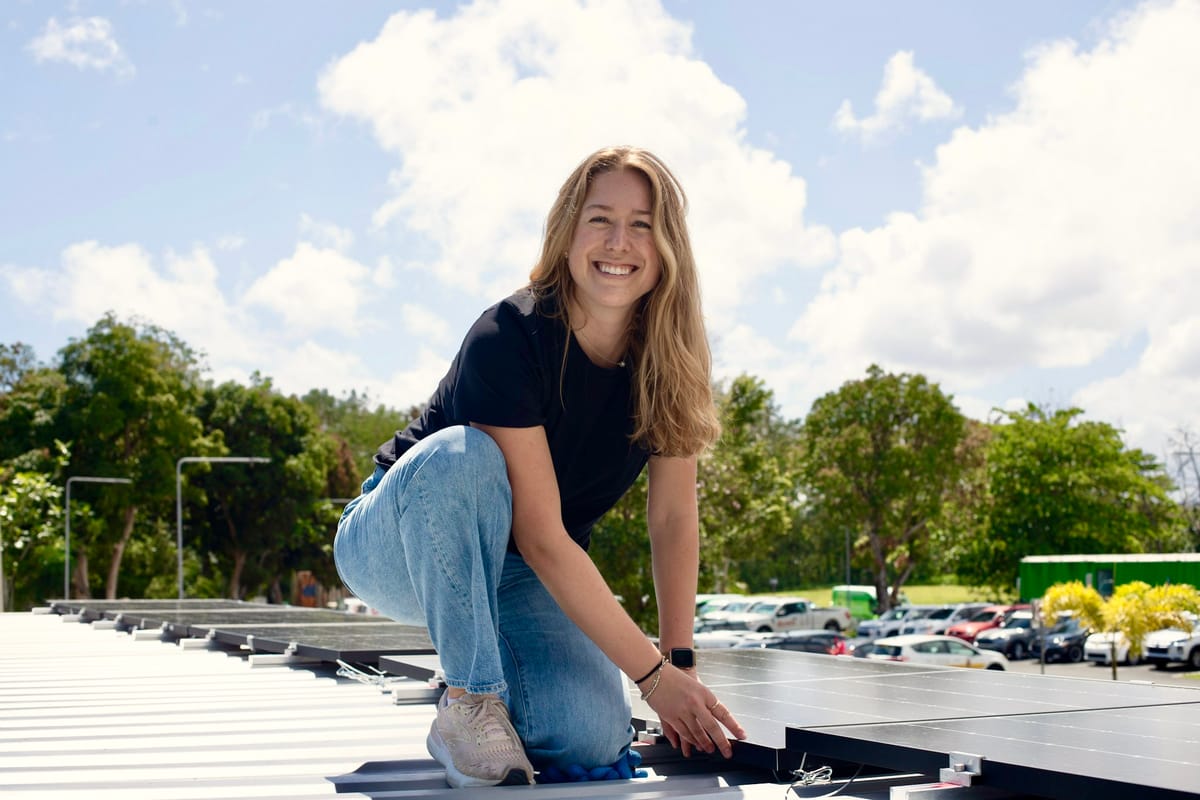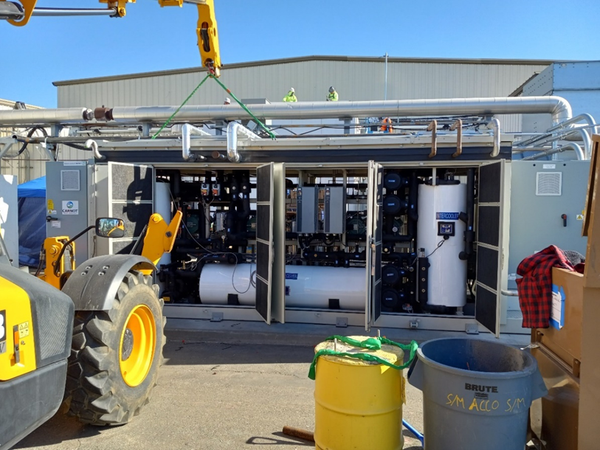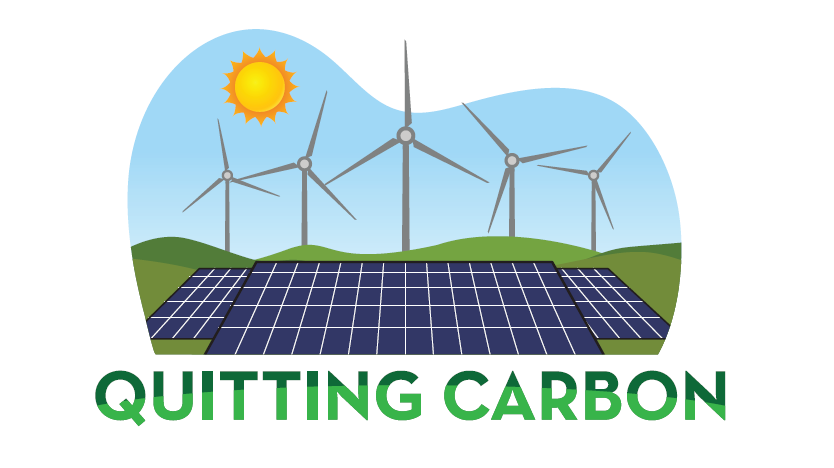Bringing small modular solar to the masses
In a conversation with Quitting Carbon, Meghan Wood, co-founder of startup Raya Power, says modular solar power systems will revolutionize energy access.

Quitting Carbon is a 100% subscriber-funded publication. To support my work, please consider becoming a paid subscriber or making a one-time donation.
Until recently, if you wanted to invest in solar power, your options were rather limited.
If you own your home, you could install a system on your roof. If you rent, you could purchase a share of the output from a community solar project. But the steep decline in the cost of solar photovoltaic modules over the past decade has unlocked a new opportunity in the sector.
Call it "modular," "portable," "plug-in," or "balcony" solar but the concept is largely the same. Super cheap solar makes it possible to deploy systems comprising a module or two on a patio, in a backyard, or, yes, on a balcony. The systems can typically be installed by the homeowner or renter, without a permit, at a fraction of the cost of a conventional rooftop PV system.
Balcony solar has famously taken off in Germany, where more than a million units have been installed, according to a registry maintained by the country’s Federal Network Agency.
Last month, IKEA started selling balcony solar kits in Germany. For around $500, customers can buy a system that includes two 450-watt (w) solar modules, cables, an 800w microinverter, and a mounting kit. For around $1,500, customers can buy a more powerful system with a 1.92 kilowatt-hour battery. Also in June, the UK government announced a safety review to allow the installation of plug-in solar systems in the country.
It has taken longer for the micro solar phenomenon to gain traction here in the U.S. As I wrote in May, Utah’s governor recently signed legislation authorizing the installation of portable solar systems in the state and the non-profit Bright Saver has started installing the systems in the greater San Francisco Bay Area.
To get a better sense of where the sector is headed and what it is offering to customers, I reached out to Meghan Wood, co-founder of the modular solar startup Raya Power.
Wood and her co-founder, Nicole Gonzalez, are working to bring a modular, “plug-and-play” solar plus battery storage system to the market by the end of this year. The system, according to the company, can be installed “in less than 2 hours, no skilled labor required,” for around $3,500 upfront or financed.
“We’ve seen a lot of excitement about the product and what it can unlock in places that couldn't access solar before,” Wood told me.
This conversation has been edited for length and clarity.
What motivated you and your co-founder to launch Raya Power?
I became passionate about climate after traveling while I was an undergrad and seeing climate impacts firsthand. I wanted to do more but didn't fully understand how. I ended up building a relationship with the Nature Conservancy in Canada while I was at Bain & Company and worked with them on regenerative agriculture.
I loved what we were doing but I wanted to have a deeper understanding of the climate problems we were facing, so I looked for a master's program and was lucky enough to come across the joint MBA and M.S. in sustainable energy at Stanford.
It is really hard to get people to adopt climate solutions. A lot of them have a ton of barriers and aren't accessible to everyday people. I felt like there wasn't anything for everyday people other than recycling or tracking your carbon footprint. Getting EVs or solar panels was challenging. I couldn't convince my family or friends to adopt them.
I started thinking about: How could we think of a better business model or innovation on the product side to make a better offering for one of these solutions? What got me excited about solar was this physical asset that could give you a positive return on investment; that seemed like something you could get people bought in on.
Initially, I was really excited about utility-scale solar. It was more efficient from a capital perspective. But what you lose in utility solar is a lot of that empowerment, giving people a way to make a difference and have resilience and bill savings at their home. And there are challenges in terms of interconnection queues and land siting. Whereas, you have your own roof available, or your own backyard available. Why can't you put solar in?
I started looking into residential solar and saw that only 40% of the cost was the hardware. The rest was the soft costs – customer acquisition, installation, permitting, design.
I was at a classmate's wedding while I was at Stanford, and I was introduced to Nicole Gonzalez, my co-founder, because she also was very passionate about solar. We talked for a few hours about residential solar and how there had to be a better way of getting it to people.
Nicole comes at this from firsthand experience having family in Puerto Rico during major hurricanes and not being able to reach them for weeks and witnessing recurring grid collapse. She had been looking for ways to solve that problem in Puerto Rico, and for other communities that face similar problems.
You've written that “solar isn't as accessible as it should be.” What flaws do you see in the traditional rooftop solar model?
When we started talking to people, the main issue was you had to own your home with residential solar. You needed a new enough roof because the system was going to be there for the next 20 plus years. You had to know you were going to stay in your home – if you are going to purchase the system outright, for 10 years to get the return on investment, or 20 plus years if you're doing a contract or to be able to sell to the next person. It just added a hurdle there.
At the same time, there were all these people who didn't own their homes, or didn't have a new roof, weren't going to be there for the next 10 years, who thought about their utility bill a lot, but they felt like they didn't have many options to reduce it.
We were seeing solutions in the do-it-yourself space. That alongside what we see happening in Germany with balcony solar. These different models, where you can make smaller systems make economic sense. The way we were selling it in the U.S. wasn't working.
The core hardware of rooftop solar is commoditized. It's a sales company either selling you on the financing or on the maintenance or on their brand reputation. And so, as a customer, you can evaluate a few different options, but now for a company, they're spending a lot of money to work with you to design a system, and at the end, you could still back out.
All of these hurdles and and market dynamics lead to high customer acquisition costs, leading to companies spending $5,000 or more to get a customer. If you spent $5,000 to get a customer, you have to put a big system on the roof, because you can't install a $3,000 system, it doesn't make economic sense. And then when you put a big system in, if there are no batteries, you have to sell back to the grid.
What will the experience look like for your customers? Where will they install the system? How big will the system be? How long will the installation take? How will they pay for the system?
We're still not fully public with all the information, but we have designed our system to avoid the complication of existing solar installations and to not require a roof for installation.
We envision a world that's close to IKEA, where you could set it up yourself, or you could pay someone to install it for you. It's more of a one-size-fits-all system that you can scale, but not requiring the custom designs, permitting, or electrical work. The system should take a couple hours to install.
You can bring it with you, if you're a renter, and move it to your next place. There are a lot more decision points open to you when you create the system more like an appliance.
Customers can buy the system outright. The cost will start at one-tenth of a rooftop solar installation. We're working with partners to develop different financing options so we can reach people who would need to pay for it monthly and start saving from day one. We’re also building relationships with philanthropic groups, looking for government funding opportunities, where we can reach the lower income communities.
You're aiming for a permit-free installation. A customer won’t need to go to their city or county to get a building permit?
That's the goal of how we're designing it. It may vary by municipality as we begin scaling. We are working with expert groups to ensure that we design the system to avoid the need for a permit.
Instead, it will be more like backyard patio furniture, rather than an actual structural change to the home. That's been top of mind for us, to make it more accessible and not have to go through that additional hurdle.
Do any technological or regulatory hurdles need to be overcome to make modular solar more mainstream in the U.S.?
We have designed our system within the confines of existing regulation in the U.S. today to ensure that we can safely get to customers from Day 1. Most of the rules stem from safety concerns, which are important to ensure a robust, long-lasting industry. Unless you're super "DIY," people don't really interact with solar and batteries, so having them feel safe and capable as we make this more accessible and scale this industry is critical.
In terms of "balcony" or "plug-in" solar, there is still a gap in regulation here, where, in Germany, over the past 10 years, they've worked to solve that. They've made it a lot more progressive in that you are allowed to plug in a certain amount of electricity back feeding an existing outlet at your home. Landlords can't say no. Utilities have to be on board. That's all really progressed in parts of Europe. They also have product certifications for safety.
In the U.S., those are lacking. There needs to be an equivalent type of safety standard developed at a testing laboratory, like UL. Having a new certificate for plug-in solar would help kickstart the balcony solar market in the U.S.
I own a rooftop solar system, which required interconnection and net-metering agreements with my utility. Will your customers not have a net-metering relationship with a utility? Will they get credit for power sent to the grid? Or is the power generated all consumed onsite? How is it reflected in a customer’s utility bill?
Our system is focused on self-consumption at the home. Given the smaller size of system and paired battery, there is less of a need to sell excess production back to the grid.
Once you get into the interconnection, you're adding soft costs. You're adding the cost of someone coming out and looking at the system, the installation, someone putting that permit in at the utility. Having to do that on a small system makes the economics really tough to pay off.
You've said that part of the goal in founding Raya Power was shaped by the experience of your co-founder, wanting to empower people in their home or apartment. Can you talk about why you see markets like Puerto Rico and the Central Valley here in California as focus areas for Raya Power?
In Puerto Rico, outages are a huge problem. Diesel generators are the main option people have right now if they can't afford a full rooftop solar installation. Otherwise, they may have a battery backup with a foldable solar panel, which they place outside specifically in an outage. Diesel generators are known for their required maintenance, frequent issues, loud noise, and fumes.
We have heard many concerns for elderly parents relying on diesel generators given the safety risks that come with using them. Battery backup systems require daily or hourly interaction to ensure they are charging and running desired appliances with extension cords running around the house. And, for the rest of the time when there is not an outage, they sit in a closet.
Having an alternative to that is a strong motivator in Puerto Rico, in addition to bill savings for electricity. An outage is of critical importance, especially for low- and moderate-income homes. If your fridge goes, everything in your fridge goes, too. If the outage lasts more than a day, that can be a couple of hundred dollars. Keeping the fridge on, keeping a fan on are critical factors in an outage. As outages continue to increase with natural disasters and grid demands from AI and data centers, we believe there will be more areas where outage resilience for core appliances is really important.
In the Central Valley, we have heard of households not turning their air conditioners on when they needed to, living in super-hot temperatures, because running the air conditioner is so expensive. Raya can help not just make a bill impact, but also a health impact by being able to keep an air conditioner running.
None of these use-cases are centered on climate-consciousness. It's a knock-on effect, which is awesome. Everyone gets this climate solution they didn't even realize was a climate solution. That gets me excited.

It's a very challenging time for rooftop solar in the U.S. There have been bankruptcies of large players in the sector. The federal tax credit for rooftop solar was eliminated in the Republican budget reconciliation bill. Where do you see Raya Power in that landscape?
It's definitely a tough time for rooftop solar. It started with the new net-metering laws. But different geopolitical or macro-level impacts have made things even worse for the industry.
It's a great time for new tech like ours to come into the market where you don't need the traditional interconnection agreements and the large-scale financing that is required to make the economics of these big systems make sense. Uncertainty around tariffs and tax credits is making traditional solar much more challenging.
What comes next for Raya Power as you grow from pilot to commercial scale?
We're in internal prototyping now and plan to launch our customer pilots in the fall. I’m really excited to run those and refine our product design and supply chains. We're actively building relationships with different partners to reach our customers at scale and to help with the financing side.
In our customer design reviews and partnership calls, we’ve seen a lot of excitement about the product and what it can unlock in places that couldn't access solar before. We wish we had a team of 50 people to work on Raya, and look forward to the day when that happens.
Are you able to mention who you're working with to manufacture the systems?
Not yet! The design of the product is still proprietary. We will have more public info to share in 2026 when we launch the product to the market.




